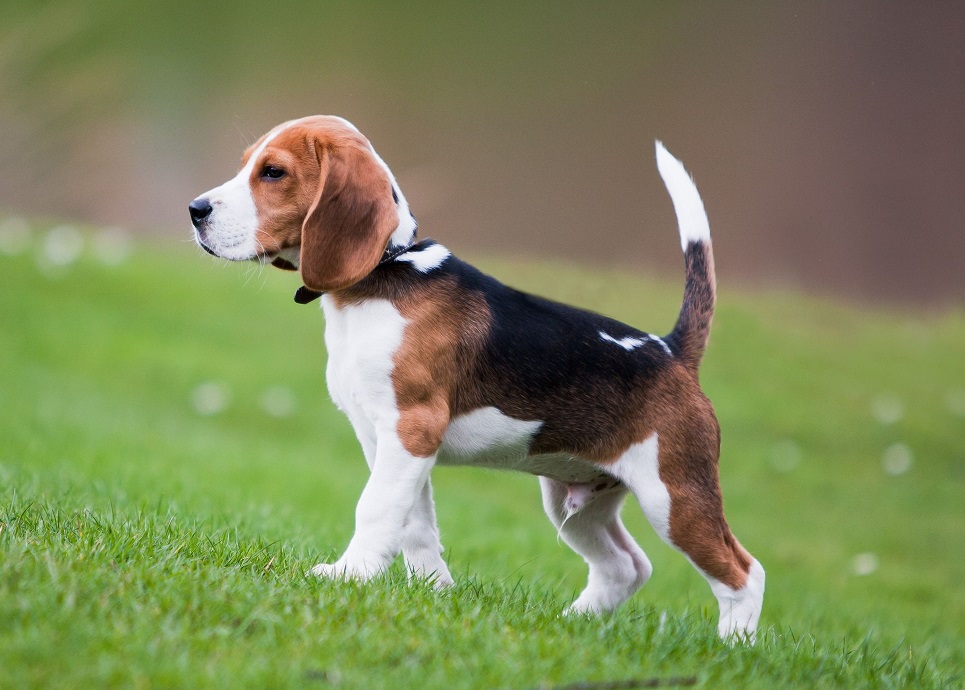
Pocket Beagle

Navigate through the tabs
Navigate through the tabs below to view the breed's info of your interest.
The breed's info is divided in four sections; namely:
the breed's history ,
the breed's main stats ,
the dog's potential health issues
and finally, how the breed scored in 26 different categories.
All the above information should give you a respectively good overview for the dog of your interest.
Dog Breed's Main Info
The Breed's History:
The origin of the word "beagle" is uncertain. It's thought that it may have been derived from the French word begueule, meaning open throat, or from the Old English word beag, meaning small. Others think it may have come from the French word beugler, meaning to bellow, or the German word begele, meaning to scold.
The breed's history is cloudy as well because breeds as we know them today didn't really develop until the 19th century. But Greek documents from 400 B.C. describe Beagle-like dogs, and the Romans may have brought small rabbit-hunting hounds with them to England and bred them with the local hounds.
William the Conqueror reportedly brought Talbot hounds (now extinct) to England during the Norman Conquest in 1066. These dogs are thought to be the ancestors of the Beagle and the Foxhound.
Beagles became popular in England early in its history. During the reigns of Edward II (1307 AD - 1327 AD) and Henry VII (1485 AD - 1509 AD), extremely small beagles, called Glove Beagles - small enough to be held in a gloved hand - were popular. There's also mention of Singing Beagles, named for their bugling voices.
Elizabeth I (1533-1603) kept packs of Pocket Beagles who stood only 9 inches tall. These small dogs were depicted in paintings as short-legged and pointy nosed. They were used for hunting, but quickly fell out of favor because they weren't very fast.
In the 1700s, fox hunting became popular in England, and the Beagle was supplanted by the larger Foxhound. If it hadn't been for the farmers in England, Ireland, and Wales who continued to keep packs to hunt rabbit and hare, the breed might have become extinct at that time.
In the mid-1800s Reverend Phillip Honeywood established a pack of Beagles in Essex, England. These dogs are thought to be the ancestors of the modern Beagle. Rev. Honeywood bred for hunting skills, not looks. Thomas Johnson, a fellow Englishman, was responsible for breeding Beagles that were both attractive and good hunters.
At about the same time, American breeders started importing Beagles from England to improve the looks of their own dogs. Many of the English imports were bred to an average height of 15 to 17 inches at the shoulder so they could hunt fox. American breeders started breeding them to be smaller for rabbit hunting.
Of interest among these rabbit-hunters is the "Patch" Beagle strain, which was developed by Willet Randall in New York around 1880. The line is primarily white with a very large tri-colored spot. They were very popular in the 1940s and 1950s because they were able to run so fast. Today, many people call lemon and white or red and white beagles "Patch" beagles.
The American Kennel Club and the first Beagle specialty club both were founded in 1884. In that same year, the AKC began registering Beagles.
Beagles compete in one of two different height classes: Beagles 13 inches tall and under compete in the 13 inch class and Beagles between 13 and 15 inches tall compete in the 15 inch class.
The American Kennel Club does not recognize a variety called the Pocket Beagle. Technically, the Pocket Beagle qualifies as a 13-inch Beagle, which is defined by the Beagle breed standard as any Beagle that doesn't exceed 13 inches in height at the shoulder and typically weighs 15 to 18 pounds.
Country of Origin:
England
Breed Group:
Hound
Height:
7 inches to 1 foot (17,78 to 30,48 cm)
Weight:
7 to 15 pounds (3,17 to 6,81 Kg)
Life Span:
12 to 15 years
Potential Health Issues:
Eye Disorders,
Hypothyroidism,
Epilepsy,
Beagle Dwarfism,
Chinese Beagle Syndrome (CBS),
Funny Puppy Syndrome,
Cleft Lip or Palate,
Cryptorchidism,
Intervertebral Disc DiseaseI (IDD),
Hermaphroditism,
Canine Hip Dysplasia,
Epiphyseal Dysplasia,
Patellar Luxation
Adaptability
Apartment Living:
First Time Owners:
Sensitivity:
Being Alone:
Cold Weather:
Hot Weather:
Friendliness
Affection With Family:
With Kids:
With Dogs:
With Strangers:
Health and Grooming
Shedding:
Drooling:
Easy To Groom:
Overall Health:
Weight Gain Potential:
Size:
Training
Easiness:
Intelligence:
Mouthiness:
Prey Drive:
Barking or Howling:
Wanderlust:
Need For Exercise
Energy Level:
Intensity:
Exercise Needs:
Playfulness:
Our Mobile Application
Check out Our Mobile Application "Dog Breeds Central"
